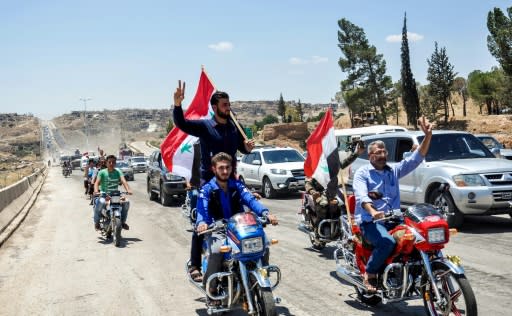Paving the way: Syria highway traces winning regime strategy
From second city Aleppo all the way down to the border with Jordan, Syria's longest highway cuts through fertile fields of green, buzzing industrial zones and four major cities. With government forces now holding a vast majority of the M5's 450 kilometres (280 miles), analysts say the highway traces two years of a winning military strategy by President Bashar al-Assad and his allies. The "international road", as it's known to Syrians, begins in the country's industrial heart Aleppo, which Assad's forces recaptured in late 2016. Last year, under an accord between Iran, Turkey and Russia, international monitors began deploying along the M5 stretch that runs through Idlib province, isolating it from surrounding rebel territory. Regime forces, also in 2017, spread through swathes of Hama further south. Assad's forces have this year already ousted rebels from Damascus and a string of towns in Homs province that lie directly on the highway. Regime forces are now waging a fierce campaign for the last strip of the route in Daraa that leads to the coveted Nasib crossing with Jordan. All along, the offensives have traced the M5. "It's quite telling -- you can go back and look at the timeline of fighting and see there's a coherent military approach to retaking the M5," said Emile Hokayem, fellow at the International Institute for Strategic Studies. "The main wealth, the industrial, infrastructural and urban areas, are located along this line," he said. "The regime all along wanted to keep control of all these nodes." - Hit the road - Before conflict erupted in 2011, the M5 was the main trade route tying Syria's commercial hub Aleppo near the Turkish border to the bustling southern crossing with Jordan. A steady stream of cargo trucks and private cars would barrel down the road, passing abundant agricultural lands and clusters of factories outside Damascus, and sometimes turning off west for Lebanon or east to Iraq. Rebels began cutting access to parts of the M5 around third city Homs and Damascus as early as 2011, and started fully capturing key stretches the following year. The regime's plan to retake it came with Russia's game-changing 2015 military intervention in the Syrian conflict, said Nawar Oliver of the Turkey-based Omran Centre. Seizing the parts around Aleppo and further south near Hama literally paved the way for further military gains. "Instead of relying on air power or side roads which still aren't safe, you can use a main road to transport material between military bases," said Oliver. According to a senior member of the loyalist National Defence Forces militia, the route was key to securing the capital this year. "There are military routes other than the official (M5) international road, whether dirt roads or airways, but the M5 is still the main lifeline for supplies to and from Damascus," he said, declining to be named. About 30 kilometres (20 miles) of the M5 cut through Eastern Ghouta and Damascus's southern suburbs, a sensitive stretch that just four months ago was rebel-held. "The army's recent operation in Eastern Ghouta allowed the route to be reopened with both sides secure from snipers, shells, mortars and other attacks," the militiaman said. - Eyes on the prize - One last section lies firmly in rebel hands. "Daraa, in a way, is the last unsecured part of this road," said Oliver. Two weeks ago, Syrian and Russian warplanes began battering opposition territory in Daraa province, which grazes the southern border with Jordan. Under mounting military pressure, rebels have agreed to hand over more than 30 towns, many of them near the M5, and regime troops have seized others by force. "Every military operation has an economic dimension," said Bassam Abou Abdallah, who heads the Damascus Centre for Strategic Studies. Daraa is no exception. Beyond the propaganda win of recapturing Daraa, the "cradle" of Syria's uprising seven years ago, Assad wants control of the M5's final stop: the Nassib border point, shuttered since 2015. "Opening the Nassib crossing would mean the activation of the international road for economic interests," said Abou Abdallah. That will be crucial for a regime making a significant comeback but still strapped for cash, Joe Macaron of the Washington-based Arab Center said. "This will give them some relief in the short term. Their base needs to have more income, they are very resource-stretched," said Macaron. Government troops could eventually turn to the segment of the M5 that runs through Idlib, currently "neutralised" by Turkey and Russia but not under full regime control. "For now, they have the upper hand and control two-thirds of the country -- they can survive and get more benefits, and at a later stage can try to continue their march," Macaron said. Cars and military vehicles drive along the main highway between Homs and Hama in central Syria Paving the way: Syrian highway traces years of regime strategy Motorcyclists carry Syrian national flags and wave as they drive along the M5 highway between Homs and Hama in the centre of the country




